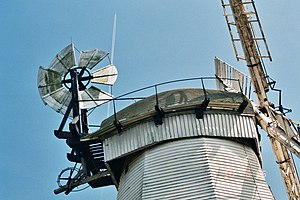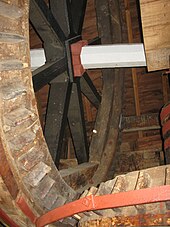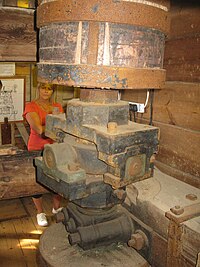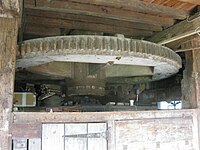Difference between revisions of "Upminster Windmill"
(Created page with "{{Infobox building |name=Upminster Windmill |county=Essex |picture=Upminster mill 150912.JPG |picture caption=The mill in September 2012. |os grid ref=TQ557867 |latitude=51.55...") |
(No difference)
|
Latest revision as of 23:09, 24 June 2024
| Upminster Windmill | |
|
Essex | |
|---|---|
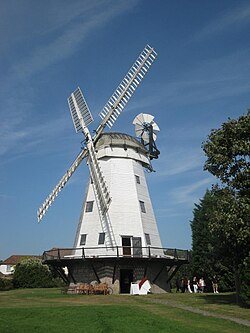 The mill in September 2012. | |
| Type: | Windmill |
| Location | |
| Grid reference: | TQ557867 |
| Location: | 51°33’29"N, 0°14’42"E |
| History | |
| Built 1803 | |
| Windmill | |
| Information | |
| Owned by: | Upminster Windmill Preservation Trust |
| Website: | upminsterwindmill.org |
Upminster Windmill is a Grade II* listed[1] smock mill located in Upminster in Essex. It was formerly known as Abraham's Mill. It has been restored and is a museum open to the public at selected times.
The mill stands today in a small open space maintained by the local council, known as 'Windmill Field'.
Contents
History
Although there had been a windmill in Upminster since at least 1768,[2] this mill was built for James Nokes of Hunt's Farm in Corbets Tey Road in 1803 on land transferred from Bridge House Farm which was owned by his brother William. It had four Common sails and drove three pairs of millstones. A steam engine was added early in 1811 driving two pairs of millstones, an action which increased the rateable value of the mill from £30 to £77.[3] A fourth pair of millstones was added to the mill. James Nokes died in 1838 and the mill passed to his son Thomas. A fifth pair of millstones had been added by 1849 when Thomas Nokes was bankrupt. By 1856 the mill was driving six pairs of millstones by wind and steam. Thomas Abraham purchased the mill in 1857, having previously been in the employ of Nokes at both West Thurrock windmill and Upminster. He had also been in business at a steam mill in Navestock for the previous two years.[4] In 1876, the upright shaft was broken in an accident at the mill. It was repaired with a cast-iron coupling.[5]
Thomas Abraham died in 1882 and the mill passed to John Arkell Abraham. In 1889 the mill was struck by lightning and on 5 January 1900 the windshaft snapped at the neck and the sails crashed to the ground. A windshaft from a post mill near Maldon was fitted along with four new sails. After the death of John Arkell Abraham, the mill passed to his nephews Thomas, Alfred and Clement. In 1927 a stock was replaced and the fantail repaired. The mill last worked commercially in 1934 and was purchased for £3,400 by W H Simmonds. The steam-driven machinery was sold and the associated outbuildings decayed and were eventually demolished.[4] The mill was subsequently purchased by Essex County Council in the late 1930s.[2]
On 22 June 2004, the Upminster Windmill Preservation Trust were granted a 35-year lease on the mill. On 18 January 2007, the windmill suffered damage in extremely high winds. The stock sustained damage as did the sail, but there was little other damage to the mill. Two new sails were fitted by Vincent Pargeter in August 2008.[6]
Description
The mill has a four-storey smock on a single-storey brick base. There is a stage at first-floor level. It has a boat-shaped cap with a gallery, winded by a six-bladed fantail. Four Patent sails are carried on a cast-iron windshaft. The mill drives four pairs of millstones by wind. The mill is 52 feet in height to the top of the cap.[5]
Base
The brick base is 24 feet 9 inches across the flats and 9 feet 6 inches high. The brickwork is 34 inches thick at ground level, diminishing to 18 inches at the top.[5]
Smock
The four-storey smock has cant posts of 13 inches by 12 inches in section, 34 feet long. The sills are 12 inches by 6 inches in section, 18 feet 4 inches long. The spout floor is 27 feet 9 inches across the flats; the stone floor is 24 feet across the flats and the top of the smock tower is 14 feet diameter at the curb. The main floor beams are 12 inches square at all levels except the dust floor. The main transoms are 8 inches by 7 inches in section at all levels.[5]
Cap and fantail
The boat-shaped cap is 17 feet 6 inches by 16 feet 10 inches in plan and 8 feet 9 inches high. The main sheer beams are 12 inches square, on 10-foot centres, with the weatherbeam of 18-inch by 12-inch section at the centre and 13 inches square at the ends. The cap is thought to be the work of the millwright William Bear of Ballingdon[5] and is unusual in having an external gallery.[2] The fantail consists of six wooden vanes set at right-angles to the sails, and has the year 1799 carved on the horizontal wooden beam beneath it.[3]
Sails and windshaft
The octagonal cast-iron windshaft has two square sections to take a head wheel and tail wheel as was its intended purpose in a post mill, and was moved to Upminster from a post mill near Maldon in 1899 to replace one broken during a storm.[3] It carries a 10-foot 4-inch diameter composite brake wheel with eight cast-iron arms and six wooden cants. The brake wheel has 78 cogs. The neck bearing of the windshaft is a roller bearing, fitted after the mill ceased working commercially.[5]
Originally Upminster windmill had canvas sails, but the sails on the mill when it ceased working commercially were four double patent sails.[3] They were carried on two stocks 46 feet long, 12 inches square at the centre, tapering to 9 inches by 6 inches at the ends. The sails were 70 feet in span, and tapered from 7 feet wide at the heel to 6 feet 6 inches at the tip. Each sail had twelve bays with three shutters per bay, giving a total of 288 shutters, each carved with a number in Roman numerals to indicate its location. The weather on the sails was 23° at the heel and almost 0° at the tip.[5]
Machinery
The upright shaft is wooden, in two sections for reasons noted above. It is twelve sided, 18 inches across the flats and 30 feet 4 inches long in total. The wallower is of compass arm construction, 5 feet 4 inches in diameter with 43 cogs. At the bottom of the upright shaft, the 10-foot diameter compass arm great spur wheel has 126 cogs. It drives four pairs of underdrift millstones via stone nuts with 24 cogs.[5]
The millstones are three pairs of French Burr stones and one pair of Peak stones. Two pairs of the French Burr stones are 4 feet 6 inches in diameter, and the other two pairs of millstones are 4 feet in diameter.[5]
Steam engine
The steam engine was located in a brick building built against the north-east side of the windmill, and drove two pairs of millstones, a centrifugal governor, and a sack hoist. The steam-driven millstones were located on two levels and driven by a shaft two and a half inches square and 50 feet length, those on the upper floor being driven by a cast-iron bevel wheel with wooden cog inserts. It was also able to work various dressing machines in the windmill, but not the wind-driven stones. There is some difference over the exact type of engine, it being variously described as a grasshopper engine built by Napiers,[5] and a Cornish boiler by Davey Paxman & Co.[3] Both sources agree that the engine had formerly been used in a Thames steamboat. The steam engine itself was removed in 1940 and taken to South West Essex Technical College in Walthamstow, while the building and remaining contents were removed in 1960, with two of the millstones remaining at the windmill entrance.[3]
Outside links
| ("Wikimedia Commons" has material about Upminster Windmill) |
- Upminster Windmill
- Windmill World webpage on Abraham's Mill
- Photos of the restoration work
- Aerial video of Upminster Windmill - YouTube
- The Assembly's "Never Never" music video – filmed at Upminster Windmill - YouTube
References
- ↑ National Heritage List 1079878: Upminster Windmill, St Marys Lane, Upminster (Grade II* listing)
- ↑ 2.0 2.1 2.2 Neale, Kenneth (1970). Discovering Essex in London. Essex Countryside. pp. 86-87. ISBN 0900519142.
- ↑ 3.0 3.1 3.2 3.3 3.4 3.5 Butler, Anthony D (1968). Upminster Mill. London: Peter R Davis.
- ↑ 4.0 4.1 Farries, Kenneth (1988). Essex Windmills, Millers and Millwrights – Volume Five – A Review by Parishes, S-Z. Edinburgh: Charles Skilton. pp. 73–76. ISBN 0-284-98821-9.
- ↑ 5.0 5.1 5.2 5.3 5.4 5.5 5.6 5.7 5.8 5.9 Farries, Kenneth (1982). Essex Windmills, Millers and Millwrights – Volume Two – A Technical Review. London & Edinburgh: Charles Skilton. pp. 52–60. ISBN 0-284-98637-2.
- ↑ "New sails for Upminster mill". Windmill World. http://www.windmillworld.com/news/archive29.htm#702.
